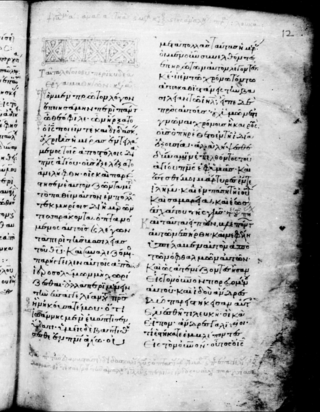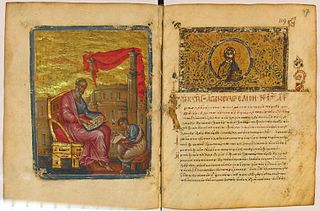
Codex Mutinensis designated by Ha or 014, α 6, is a Greek uncial manuscript of the Acts of Apostles, dated paleographically to the 9th century. The codex contains 43 parchment leaves.

Codex Angelicus designated by Lap or 020, α 5, is a Greek uncial manuscript of the New Testament. Palaeographically it has been assigned to the 9th century. Formerly it was known as Codex Passionei.

Codex Basilensis A. N. IV. 2, known as Minuscule 1, δ 254, and formerly designated by 1eap to distinguish it from minuscule 1rK is a Greek minuscule manuscript of the entire New Testament, apart from the Book of Revelation. Using the study of comparative writings styles (palaeography), it is usually dated to the 12th century CE.

Minuscule 33, δ 48 (Soden), before the French Revolution was called Codex Colbertinus 2844. It is a Greek minuscule manuscript of the New Testament on parchment, dated palaeographically to the 9th century. The manuscript is lacunose. It has marginalia. According to the textual critics it is one of the best minuscule manuscripts of the New Testament.

Minuscule 5, δ 453, is a Greek minuscule manuscript of the New Testament, on 342 parchment leaves. Using the study of comparative writing styles (palaeography), it has been dated to the 13th century.

Minuscule 51, δ 364, is a Greek minuscule manuscript of the New Testament, on parchment leaves. Palaeographically it has been assigned to the 13th century. Formerly it was labelled by 51e for the Gospels, 32a for the Acts, and 38p for the Pauline epistles. It has marginalia.
Minuscule 189, α 269 (Soden), is a Greek minuscule manuscript of the New Testament, on parchment. Palaeographically it has been assigned to the 14th century. It has marginalia.
Minuscule 242, δ 206 (Soden), is a Greek minuscule manuscript of the New Testament, on parchment. Palaeographically it has been assigned to the 12th century.

Minuscule 330, δ 259 (Soden), is a Greek minuscule manuscript of the New Testament, on parchment. Palaeographically it has been assigned to the 12th century. It has marginalia. The Greek text of the codex is a representative of the Byzantine text-type.
Minuscule 363, δ 455 (Soden), is a Greek minuscule manuscript of the New Testament, on parchment. Paleographically it has been assigned to the 14th century. It was adapted for liturgical use.
Minuscule 431, δ 268, is a Greek minuscule manuscript of the New Testament, on parchment. Palaeographically it has been assigned to the 12th century. It has marginalia. It is known as Codex Molsheimensis.
Minuscule 450, α 63, is a Greek minuscule manuscript of the New Testament, on parchment. Palaeographically it has been assigned to the 11th century. Formerly it was labelled by 78a and 89p. The manuscript is lacunose.
Minuscule 479, δ 2491, is a Greek minuscule manuscript of the New Testament, on parchment. Palaeographically it has been assigned to the 13th century. Scrivener labelled it by number 542. It was adapted for liturgical use. Marginalia are not complete.
Minuscule 498, δ 402, is a Greek minuscule manuscript of the New Testament, on parchment. Palaeographically it has been assigned to the 14th-century. Scrivener labelled it by number 584. The manuscript is lacunose.
Minuscule 547, δ 157, is a Greek minuscule manuscript of the New Testament, on parchment. Palaeographically it has been assigned to the 11th century. Scrivener labelled it by number 534.
Minuscule 614, α 364, is a Greek minuscule manuscript of the New Testament, on parchment. Palaeographically it has been assigned to the 13th century. The manuscript is lacunose. Tischendorf labelled it by 137a and 176p.
Minuscule 623, α 173, is a Greek diglot minuscule manuscript of the New Testament, on parchment. It is dated by a colophon to the year 1037. The manuscript is lacunose. Tischendorf labeled it by 156a and 190p.
Minuscule 638, α 188, is a Greek minuscule manuscript of the New Testament, on parchment. Palaeographically to the 11th century. The manuscript is lacunose. Scrivener labelled it by 191a and 245p.
Minuscule 665, α 354, is a Greek minuscule manuscript of the New Testament, on parchment. Palaeographically it has been assigned to the 13th century. The manuscript is lacunose. Gregory labelled it by 222a and 277p. Scrivener labelled it by 213a and 251p.
Minuscule 901, δ 162, is an 11th-century Greek minuscule manuscript of the New Testament on parchment. It has marginalia. The manuscript has survived in its complete form.







